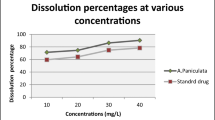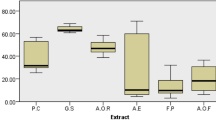Abstract
Urinary stone disease is a widespread health problem in both adults and children, and its prevalence has been increasing worldwide. Various plants preparations have already been used since ancient times in order to treat urolithiasis. The aim of this study is to evaluate the antioxidant capacity and litholytic effect on kidney stones of Cydonia oblonga Miller. leaves. The infusion, methanol and acetone extracts were made from Cydonia oblonga Miller. leaf at different concentration. Estimation of mass fractions of total polyphenol, flavonoid, and flavonol contents, as well as the in vitro radical scavenging potential on 2,2ʹ-diphenyl-1-picrylhydrazyl radical (DPPH·) of the investigated extracts was carried out using colorimetric methods. The litholytic property of the extracts was performed by an in-vitro model using experimentally prepared kidney stones- calcium oxalate. As results, the quince leaf extracts revealed stronger antioxidant properties in the DPPH assay, which was proved by the semi-maximal inhibitory concentration values, being about 36.06 ± 3.55, 74.15 ± 6.29, and 142.35 ± 5.09 µg/ml for methanol, acetone and infusion extracts respectively. Furthermore, the tested extracts were found to be more effective in dissolving calcium oxalate stones compared to the control solutions, the mass loss is about 15.13 ± 1.10% with methanol extract, while it is 14.77 ± 1.74% and 11.14 ± 2.86% for acetone and infusion extracts respectively. These findings confirm the quince leaf's richness in phyto-components, offering anti-oxidant property and being able to be used as a remedy for the management of kidney stones by dissolving calcium oxalate stones in the kidneys.







Similar content being viewed by others
References
Stojanović BT, Mitić SS, Stojanović GS et al (2017) Phenolic profiles and metal ions analyses of pulp and peel of fruits and seeds of quince (Cydonia oblonga Mill.). Food Chem 232:466–475. https://doi.org/10.1016/j.foodchem.2017.04.041
Oliveira AP, Pereira JA, Andrade PB et al (2007) Phenolic profile of Cydonia oblonge Miller leaves. J Agric Food Chem 55:7926–7930. https://doi.org/10.1021/jf0711237
Oliveira AP, Pereira JA, Andrade PB et al (2008) Organic acids composition of Cydonia oblonga Miller leaf. Food Chem 111:393–399. https://doi.org/10.1016/j.foodchem.2008.04.004
Srirama R, Senthilkumar U, Sreejayan N et al (2010) Assessing species admixtures in raw drug trade of Phyllanthus, a hepato-protective plant using molecular tools. J Ethnopharmacol 130:208–215
Jouyban A, Shoja MM, Ardalan MR et al (2011) The effect of quince leaf decoction on renal injury induced by hypercholesterolemia in rabbits: a pilot study. J Med Plant Res 5:5291–5295
Vaez H, Hamidi S, Arami S (2014) Potential of Cydonia oblonga leaves in cardiovascular disease. Hypothesis 12:1–10
Janbaz KH, Shabbir A, Mehmood MH, Gilani AH (2013) Insight into mechanism underlying the medicinal use of Cydonia oblonga in gut and airways disorders. J Anim Plant Sci 23:330–336
Minaiyan M, Ghannadi A, Etemad M, Mahzouni P (2012) A study of the effects of Cydonia oblonga Miller (Quince) on TNBS-induced ulcerative colitis in rats. Res Pharm Sci 7:103
Costa RM, Magalhães AS, Pereira JA et al (2009) Evaluation of free radical-scavenging and antihemolytic activities of quince (Cydonia oblonga) leaf: a comparative study with green tea (Camellia sinensis). Food Chem Toxicol 47:860–865. https://doi.org/10.1016/j.fct.2009.01.019
Magalhães AS, Silva BM, Pereira JA et al (2009) Protective effect of quince (Cydonia oblonga Miller) fruit against oxidative hemolysis of human erythrocytes. Food Chem Toxicol 47:1372–1377. https://doi.org/10.1016/j.fct.2009.03.017
Alesiani D, Canini A, D’Abrosca B et al (2010) Antioxidant and antiproliferative activities of phytochemicals from Quince (Cydonia vulgaris) peels. Food Chem 118:199–207. https://doi.org/10.1016/j.foodchem.2009.04.098
Benzarti S, Hamdi H, Lahmayer I et al (2015) Total phenolic compounds and antioxidant potential of quince (Cydonia oblonga Miller) leaf methanol extract. Int J Innov Appl Stud 13:518–526
Din Ganaie MU, Behl T, Nijhawan P et al (2020) Investigation of anti-depressant effect of aqueous and ethanolic extract of Cydonia oblonga in rats. Obes Med 18:100202. https://doi.org/10.1016/j.obmed.2020.100202
El Habbani R, Chaqroune A, Arrayhani M et al (2016) Epidemiological study on urinary stones in the region of Fez and the risk of recurrence. Progres en Urologie: Journal de l’association Francaise d’urologie et de la Societe Francaise d’urologie 26:287–294
Daudon M, Bader CA, Jungers P et al (1993) Urinary calculi: review of classification methods and correlations with etiology. Scan Microsc 7:32
Elliot JS, Rabinowitz IN (1980) Calcium oxalate crystalluria: crystal size in urine. J Urol 123:324–327
Castiglione V, Jouret F, Bruyere O et al (2015) Epidémiologie de la lithiase urinaire en Belgique sur base d’une classification morpho-constitutionnelle. Nephrol Ther 11:42–49
Daudon M, Letavernier E, Frochot V et al (2016) Respective influence of calcium and oxalate urine concentration on the formation of calcium oxalate monohydrate or dihydrate crystals. C R Chim 19:1504–1513
María R, Shirley M, Xavier C et al (2018) Preliminary phytochemical screening, total phenolic content and antibacterial activity of thirteen native species from Guayas province Ecuador. J King Saud Univ Sci 30:500–505. https://doi.org/10.1016/j.jksus.2017.03.009
Miliauskas G, Venskutonis PR, Van Beek TA (2004) Screening of radical scavenging activity of some medicinal and aromatic plant extracts. Food Chem 85:231–237. https://doi.org/10.1016/j.foodchem.2003.05.007
Awah FM, Uzoegwu PN, Ifeonu P et al (2012) Free radical scavenging activity, phenolic contents and cytotoxicity of selected Nigerian medicinal plants. Food Chem 131:1279–1286. https://doi.org/10.1016/j.foodchem.2011.09.118
Kumaran A, Joel Karunakaran R (2007) In vitro antioxidant activities of methanol extracts of five Phyllanthus species from India. LWT Food Sci Technol 40:344–352. https://doi.org/10.1016/j.lwt.2005.09.011
Rondón M, García I, Cornejo X et al (2015) Phytochemical screening and antioxidant activity of seven medicinal plants species from Ecuador. Pharmacologyonline 3:19–28
Saso L, Valentini G, Leone MG et al (1998) Development of an in vitro assay for the screening of substances capable of dissolving calcium oxalate crystals. Urol Int 61:210–214. https://doi.org/10.1159/000030331
Ghosh S, Basu S, Chakraborty S, Mukherjee AK (2009) Structural and microstructural characterization of human kidney stones from eastern India using IR spectroscopy, scanning electron microscopy, thermal study and X-ray Rietveld analysis. J Appl Crystallogr 42:629–635. https://doi.org/10.1107/S0021889809016446
Orlando MTD, Kuplich L, de Souza DO et al (2008) Study of calcium oxalate monohydrate of kidney stones by X-ray diffraction. Powder Diffr 23:S59–S64. https://doi.org/10.1154/1.2903738
Leroy C (2017) Oxalates de calcium et hydroxyapatite: des matériaux synthétiques et naturels étudiés par techniques RMN et To cite this version : HAL Id : tel-01443727 Oxalates de calcium et hydroxyapatite : des matériaux
Ghosh S, Bhattacharya A, Chatterjee P, Mukherjee AK (2014) Structural and microstructural chracterization of seven human kidney stones using FTIR spectroscopy, SEM, thermal study and X-ray Rietveld analysis. Zeitschrift fur Kristallographie 229:451–458. https://doi.org/10.1515/zkri-2014-1725
Bhattacharyya S, Mandal AK, Singh SK (2014) Analysis of the chemical composition of urinary calculi using Fourier transform infrared spectroscopy: a preliminary study. J Postgrad Med Educ Res 48:128–131. https://doi.org/10.5005/jp-journals-10028-1117
Chirinos R, Rogez H, Campos D et al (2007) Optimization of extraction conditions of antioxidant phenolic compounds from mashua (Tropaeolum tuberosum Ruíz & Pavón) tubers. Sep Purif Technol 55:217–225. https://doi.org/10.1016/j.seppur.2006.12.005
Zhang L, Rocchetti G, Zengin G et al (2021) The Uhplc-Qtof-Ms phenolic profiling and activity of Cydonia oblonga mill. Reveals a promising nutraceutical potential. Foods 10:1230. https://doi.org/10.3390/foods10061230
Iqbal E, Kamariah AS, Linda BLL (2015) Phytochemical screening, total phenolics and antioxidant activities of bark and leaf extracts of Goniothalamus velutinus (Airy Shaw) from Brunei Darussalam. J King Saud Univ Sci 27:224–232. https://doi.org/10.1016/j.jksus.2015.02.003
Khouchlaa A, Talbaoui A, El Yahyaoui El Idrissi A et al (2017) Détermination des composés phénoliques et évaluation de l’activité litholytique in vitro sur la lithiase urinaire d’extrait de Zizyphus lotus L. d’origine marocaine. Phytothérapie 1–6
Kachkoul R, Squalli Housseini T, Mohim M et al (2019) Chemical compounds as well as antioxidant and litholytic activities of Arbutus unedo L. leaves against calcium oxalate stones. J Integr Med 17:430–437. https://doi.org/10.1016/j.joim.2019.08.001
Ammor K, Mahjoubi F, Bousta D et al (2020) In vitro litholytic activity of extracts and phenolic fractions of some medicinal plants on urinary stones. Mediterr J Chem 9:468–477. https://doi.org/10.13171/mjc9602001101135ka
Meiouet F, El Kabbaj S, Daudon M (2011) Étude in Vitro De L’Activité Litholytique De Quatre Plantes Médicinales Vis-À-Vis Des Calculs Urinaires De Cystine. Prog Urol 21:40–47. https://doi.org/10.1016/j.purol.2010.05.009
Author information
Authors and Affiliations
Contributions
I.E and L.B conceived of the presented idea. I.E developed the theory, performed the computations and wrote the main manuscript text. M.B supervised the findings of this work.
Corresponding author
Ethics declarations
Conflict of interest
The authors declare that they have no conflict of interest.
Additional information
Publisher's Note
Springer Nature remains neutral with regard to jurisdictional claims in published maps and institutional affiliations.
Rights and permissions
Springer Nature or its licensor (e.g. a society or other partner) holds exclusive rights to this article under a publishing agreement with the author(s) or other rightsholder(s); author self-archiving of the accepted manuscript version of this article is solely governed by the terms of such publishing agreement and applicable law.
About this article
Cite this article
Elhadri, I., Baddade, L. & Berkani, M. Antioxidant activity and Inhibitory effects of Cydonia oblonga Miller. leaves extracts against calcium oxalate stones. Urolithiasis 52, 62 (2024). https://doi.org/10.1007/s00240-024-01532-z
Received:
Accepted:
Published:
DOI: https://doi.org/10.1007/s00240-024-01532-z




